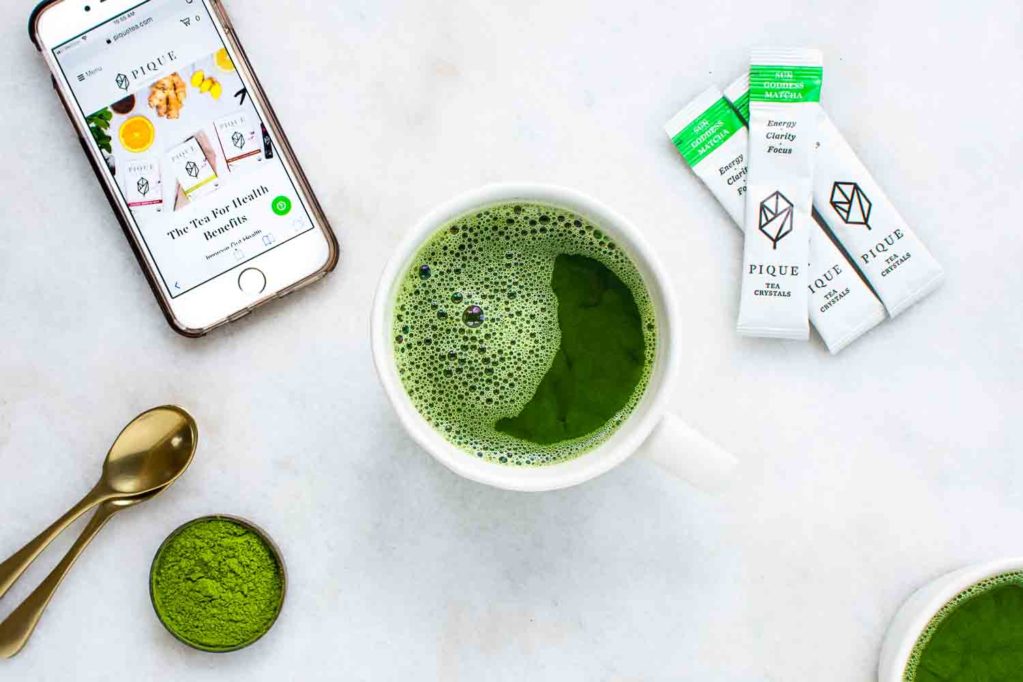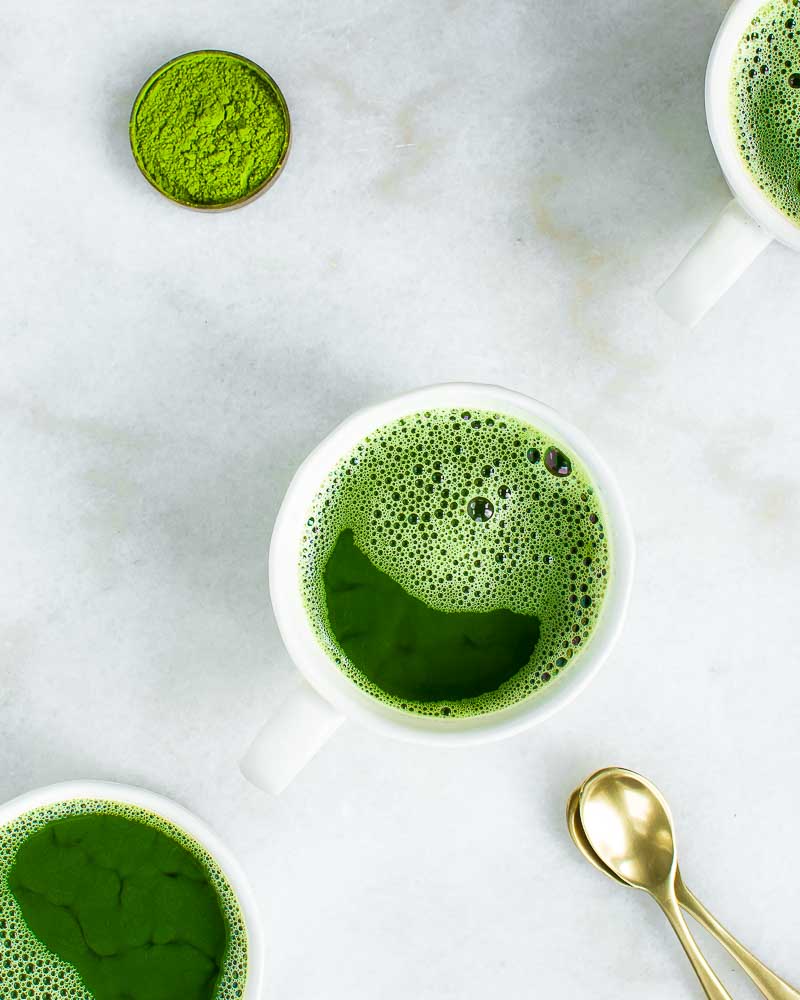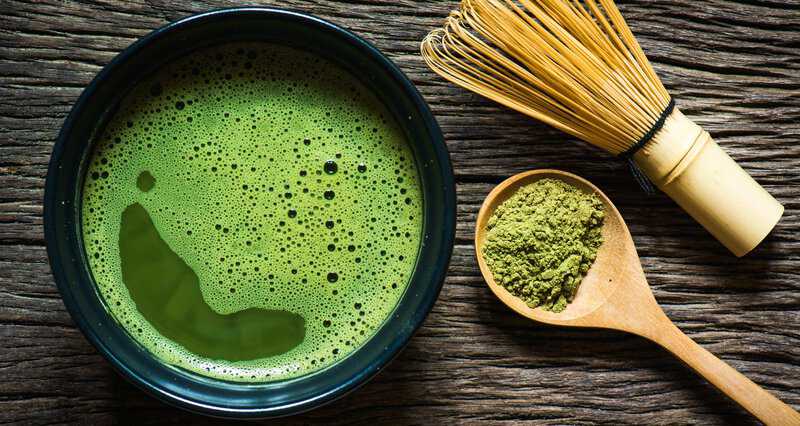

Matcha green tea, with its resonant flavor and vivid green color, has become increasingly popular, largely because it is powerfully rich in antioxidants and key nutrients that help to support relaxation while also improving blood sugar balance, cardiovascular health and gut health. This guide will fill you in on where to buy matcha tea, what to look for and how to know you’re getting the best quality, too.
What is matcha tea?
Matcha tea is a traditional Japanese green tea. The tea plants are grown in the shade which increases their chlorophyll content, making for a brilliant and vibrant green color. Shade growing the tea plants also increases their L-theanine content, or the amino acid that’s responsible for tea’s soothing properties. Only the young buds are harvested for matcha, and tea producers lay these leaves flat to dry before removing their veins and stems, and then grinding the tea into a very fine powder which is called matcha.
Matcha is traditionally used ceremonially in Japan, and, recently, it has been used to flavor a wide variety of foods both inside Japan and throughout the world. Matcha Tea Lattés are particularly popular, and sweets like popsicles or milk shakes also feature matcha as a primary flavor.
What are the benefits of matcha tea?
The way in which matcha tea is grown and produced make it particularly nutrient-dense and richer in certain amino acids and phytonutrients than other teas. When tea plants are grown in the shade and without access to sunlight, they naturally produce higher levels of theanine, chlorophyll and polyphenols, which makes matcha tea more nutrient-dense and higher in key antioxidants than most green teas.
It’s these key components – amino acids and antioxidants – that convey many of the benefits of matcha tea.
L-theanine, a naturally-occurring amino acid found in the tea plant that increases when the tea plant is grown in the shade, promotes relaxation and acts to reduce feelings of stress (source). L-theanine also helps to enhance concentration, alertness and cognitive performance while simultaneously supporting relaxation (source, source).
The way tea growers produce matcha is fairly unique, and it results in tea with a much higher concentration of antioxidants. High-quality matcha tea may have up to 137 times the antioxidant level found in lower grade, bagged green teas (source). Antioxidants help to reduce the oxidative stress and inflammation that is at the root of many chronic diseases.
What’s particularly interesting is that the polyphenols found in abundance in matcha tea help to support both cardiovascular and gut health.
Green teas like matcha contain many components that help to support heart health (source) and may do so because these micronutrients help to support blood sugar regulation and lipid metabolism (source) while also mitigating oxidative stress (source).
The polyphenols in green tea, which are more concentrated in matcha than other teas, also help to support gut health and optimal weight (source). The phytonutrients found in green teas, like matcha, help to inhibit oxidative stress in the gut, which can then improve gut health (source). The polyphenols in tea also foster changes in the gut, encouraging microbial diversity (source) and a healthier microbiome (source).
What to look for when buying matcha?
If you’re wondering what to look for when you buy matcha or where to buy matcha tea, there’s a few things you should consider to ensure quality, flavor and authenticity.
When purchasing matcha, you should look for matcha that is shade-grown in Japan and that has a rich and vibrant green color. It should also be free from additives and screened for heavy metals and other contaminants. Further, it should be stored and sold in containers or packages that minimize oxidation – or you’ll lose both the flavor and nutritive quality of the tea.
Authentic matcha is shade-grown in Japan and carefully processed to produce a vibrant, vivid green and resonantly flavorful powder. The vivid green color is an excellent indicator of the presence of phytonutrients like chlorophyll. The richer the color, the more nutrient-dense the tea.
The tea plant, like other crops, will take up heavy metals and fluoride from the soil in the same way it takes up minerals and nutrients. For this reason, teas including matcha may contain contaminants (source). Higher quality teas, teas made from young leaves and buds such as matcha, and organically grown teas will tend to have fewer contaminants and lower fluoride levels than poorer quality teas (source).
When buying matcha, remember:
- The best matcha is grown in Japan.
- The best matcha is shade-grown.
- Matcha should be a rich and vibrant green.
- Screened for heavy metals and other contaminants.
- Matcha should be sold in ways that minimize oxidation.
Because tea can naturally contain contaminants, it’s important to purchase high-quality tea and to buy tea that screens for those contaminants. Pique Tea is unique in that their matcha goes through a quadruple screening process that screens for heavy metals, fluoride, toxic mold, pesticides and radioactive isotopes.
What’s the best matcha powder?
Matcha is classified into three grades depending on the quality of the tea. When you’re looking for where to buy matcha, pay attention to its quality as well as its grade. How the tea was grown and produced, the color and texture of the matcha powder, and the degree of oxidation are all factors that can influence how and individual tea is graded. Matcha is classified into three grades: ceremonial, premium and culinary, with ceremonial grade matcha considered to be the highest quality.
The three grades of matcha include:
- Ceremonial Matcha is the highest quality, and it is primarily used in tea ceremonies and temples. It has a very high amino acid content, compared to other matcha teas, and so has subtle umami notes and a richly complex flavor.
- Premium Matcha is rich in phytonutrients and amino acids, but tends to be less expensive and less richly flavored than ceremonial matcha but a much higher quality than culinary matcha.
- Culinary Matcha is the least expensive option, it has a less vibrant green color and less complex flavor with stronger bitter notes. It tends to be more highly oxidized and is primarily used as a flavoring for foods and beverages.
Where to Buy Matcha Tea
If you’re looking for where to buy matcha tea, you have a few resources. You can find matcha tea at some natural foods markets and tea shops, but it’s easier to find consistently high quality matcha tea powders from specialty providers online.
Pique Tea offers a ceremonial grade matcha from southern Japan. And like all authentic matcha, it is shade-grown. What makes it a fairly unique product; however, is that it is shade-grown 35% longer than average, which results in a higher level of L-theanine, an amino acid that helps increase relaxation and soothe stress.
They also screen their matcha for heavy metals, fluoride, pesticides, toxic mold, and radioactive isotopes, ensuring you the matcha is not only of the highest quality, but also the cleanest, too. It’s also packaged in individual servings to prevent oxidation.
You can order it online here.

First appeared on nourishedkitchen.com

